November Organics
When I walk the produce department this time of year I am still delighted and amazed when I look at the different colors, shapes, and textures of the Melissa’s winter squash display. It almost feels like I opened an ancient treasure chest to find a cache of multi-colored jewels.
And in some ways, this isn’t so far from the truth. These beauties have a long history of sustaining folks through the long winters when they couldn’t grow food in many parts of the country. They also have a variety of wonderful flavors, and are high in vitamin A. They also make a great complement to the root vegetables you will find in your produce department, like Melissa’s turnips and rutabagas, which contain good amounts of vitamin C. This combination of vitamins works well together to help keep you healthy in the cold winter months. When you buy Melissa’s organic winter squash, you will be eating the healthiest squash as well. Why, you ask? You see, winter squash has the ability to store pesticides that it has absorbed from the ground. In some cases, squash has shown the ability to absorb pesticides years after they have been used, as they still persist in the soil. So in my opinion, Melissa’s organic winter squash is the way to go. If you are ready to dive into the treasure trove of squash next time you shop, here is a description of some of the Melissa’s winter squash varieties you may find:
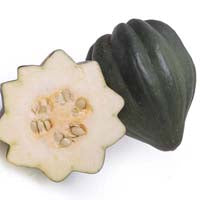
Acorn
Named for its acorn-like shape, acorn squash is mostly dark green in color, but can be found orange-colored as well. It ranges from 4 to 6 inches around and weighs 1 to 2 pounds. To bring out the flavors of this squash, I would bake it.
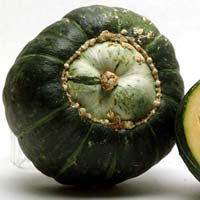
Buttercup
This dark green or pumpkin-colored squash can be a stocky 6 to 8 inches in diameter, averaging 2 to 4 pounds. Its claim to fame is its sweet and creamy orange flesh. Though the flesh can be a bit dry, steaming can solve this problem.
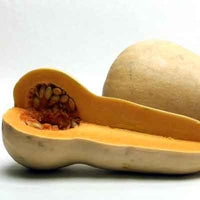
Butternut
Light brown with a long neck and bell or bulb bottom, it can range from 6 inches to about a foot long and weigh from 1/2 to 4 pounds. It is meaty and thin skinned, with a moist, sweet, golden-orange flesh. Baking brings out its sweet, nutty flavor.
Hubbard
It comes in colors of green, gold, blue, and baby blue. It is tear-shaped and can weigh from 5 to 50 pounds. The flesh is thick, sweet, and a bit dry. Steaming will help this. Don’t let the size keep you from trying one; it is worth asking your local produce clerk to cut a piece to your liking.
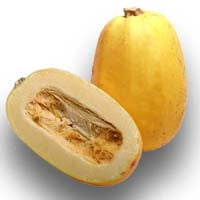
Spaghetti
Vegetable spaghetti? Yes, that is what you will get when you buy this oval-shaped yellow squash. When cooked, its spaghetti-like strands are tender and have a mild, lightly sweet and fresh taste. They average 9 inches in length and about 2 to 3 pounds.
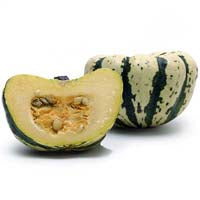
Sweet Dumpling
This is a perfect one-person squash as it is a bit bigger than an apple and weighs up to 1 pound. It can be identified by its creamy color, green stripes, and round shape. It has a pale-yellow flesh, with a light to mild sweetness and a relatively tender skin that can be eaten.
This is only the top layer of the treasure you’ll find in the squash display. There are many other jewels to discover. And as you find yourself in the kitchen this month, you’ll find that winter squash can be a great addition to a Wednesday night supper or a fabulous Thanksgiving meal.
If you are new to squash, try baking them, as this brings out the sweet flavor of the squash by caramelizing some the sugars. Simply cut the squash in half lengthwise and remove the seeds and strings. Place squash, cut-side down, in a baking pan. Add ¼ to ½ inch of water to the pan, and bake at 350°F to 400°F for 40 to 45 minutes or until tender. You’ll know it’s done when a fork can pierce the skin with ease. Some folks add butter to the cooked squash, but I recommend tasting it first, as you’ll be surprised how good it can taste on its own. Savor the treasure and share the bounty!
And in some ways, this isn’t so far from the truth. These beauties have a long history of sustaining folks through the long winters when they couldn’t grow food in many parts of the country. They also have a variety of wonderful flavors, and are high in vitamin A. They also make a great complement to the root vegetables you will find in your produce department, like Melissa’s turnips and rutabagas, which contain good amounts of vitamin C. This combination of vitamins works well together to help keep you healthy in the cold winter months. When you buy Melissa’s organic winter squash, you will be eating the healthiest squash as well. Why, you ask? You see, winter squash has the ability to store pesticides that it has absorbed from the ground. In some cases, squash has shown the ability to absorb pesticides years after they have been used, as they still persist in the soil. So in my opinion, Melissa’s organic winter squash is the way to go. If you are ready to dive into the treasure trove of squash next time you shop, here is a description of some of the Melissa’s winter squash varieties you may find:

Acorn
Named for its acorn-like shape, acorn squash is mostly dark green in color, but can be found orange-colored as well. It ranges from 4 to 6 inches around and weighs 1 to 2 pounds. To bring out the flavors of this squash, I would bake it.

Buttercup
This dark green or pumpkin-colored squash can be a stocky 6 to 8 inches in diameter, averaging 2 to 4 pounds. Its claim to fame is its sweet and creamy orange flesh. Though the flesh can be a bit dry, steaming can solve this problem.

Butternut
Light brown with a long neck and bell or bulb bottom, it can range from 6 inches to about a foot long and weigh from 1/2 to 4 pounds. It is meaty and thin skinned, with a moist, sweet, golden-orange flesh. Baking brings out its sweet, nutty flavor.
Hubbard
It comes in colors of green, gold, blue, and baby blue. It is tear-shaped and can weigh from 5 to 50 pounds. The flesh is thick, sweet, and a bit dry. Steaming will help this. Don’t let the size keep you from trying one; it is worth asking your local produce clerk to cut a piece to your liking.

Spaghetti
Vegetable spaghetti? Yes, that is what you will get when you buy this oval-shaped yellow squash. When cooked, its spaghetti-like strands are tender and have a mild, lightly sweet and fresh taste. They average 9 inches in length and about 2 to 3 pounds.

Sweet Dumpling
This is a perfect one-person squash as it is a bit bigger than an apple and weighs up to 1 pound. It can be identified by its creamy color, green stripes, and round shape. It has a pale-yellow flesh, with a light to mild sweetness and a relatively tender skin that can be eaten.
This is only the top layer of the treasure you’ll find in the squash display. There are many other jewels to discover. And as you find yourself in the kitchen this month, you’ll find that winter squash can be a great addition to a Wednesday night supper or a fabulous Thanksgiving meal.
If you are new to squash, try baking them, as this brings out the sweet flavor of the squash by caramelizing some the sugars. Simply cut the squash in half lengthwise and remove the seeds and strings. Place squash, cut-side down, in a baking pan. Add ¼ to ½ inch of water to the pan, and bake at 350°F to 400°F for 40 to 45 minutes or until tender. You’ll know it’s done when a fork can pierce the skin with ease. Some folks add butter to the cooked squash, but I recommend tasting it first, as you’ll be surprised how good it can taste on its own. Savor the treasure and share the bounty!

